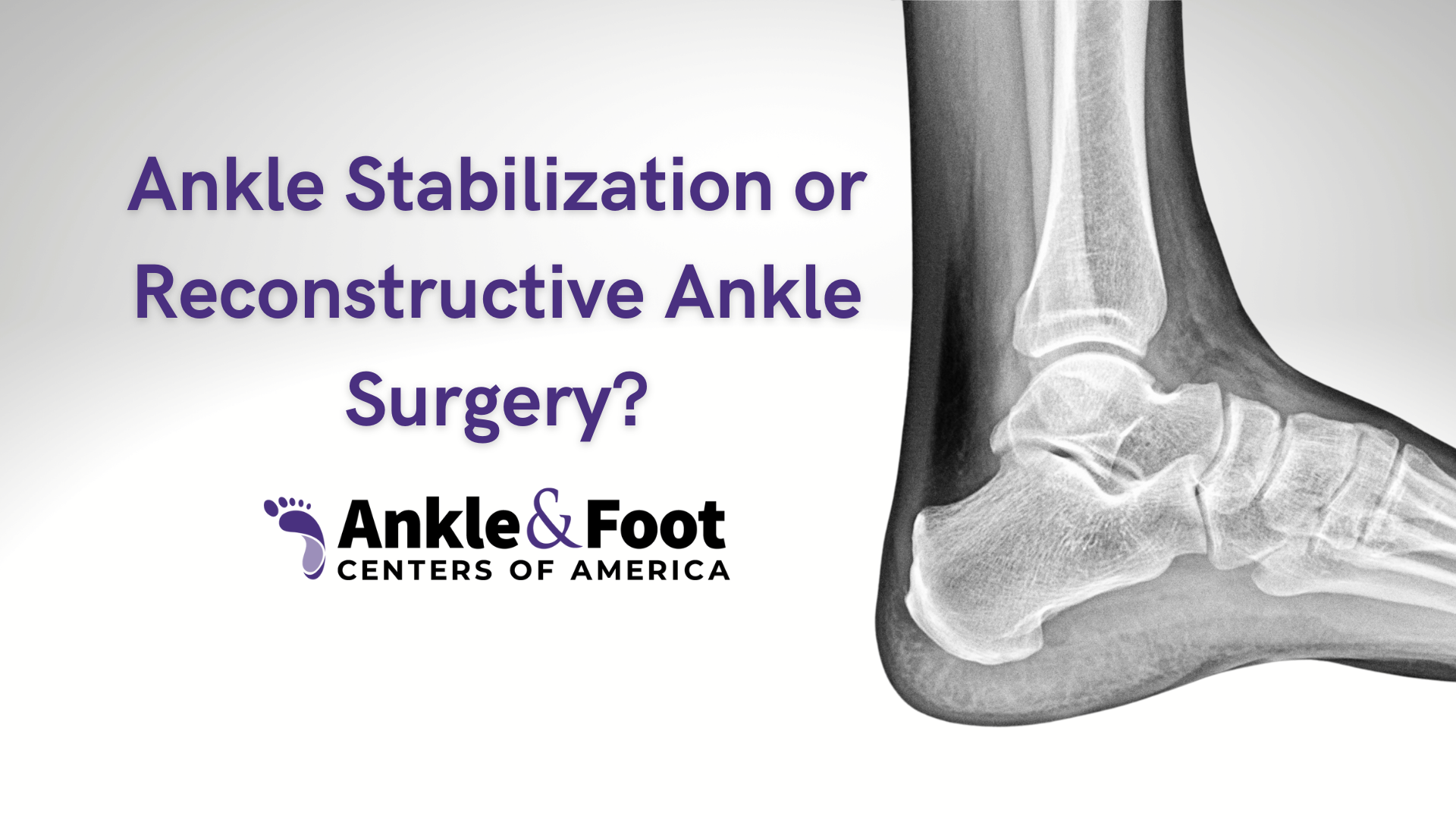In the world of orthopedics, ankle stabilization surgery stands out as a pivotal procedure that has been instrumental in restoring mobility and quality of life for numerous patients. Whether it’s due to a sport-related injury, chronic instability, or a severe sprain, this surgery can offer a much-needed solution. But, as with any surgical procedure, it’s important to understand what it entails and why it’s needed.
What is Ankle Stabilization Surgery?
 Ankle stabilization surgery, also referred to as ankle ligament repair, is a procedure designed to correct chronic ankle instability. The surgery tightens loosened ligaments surrounding the ankle and, in certain cases, reconstructs damaged ligaments using tissues from other parts of the body. The overarching goal is to enhance the stability of the ankle, reduce discomfort, and minimize the risk of future sprains or injuries.
Ankle stabilization surgery, also referred to as ankle ligament repair, is a procedure designed to correct chronic ankle instability. The surgery tightens loosened ligaments surrounding the ankle and, in certain cases, reconstructs damaged ligaments using tissues from other parts of the body. The overarching goal is to enhance the stability of the ankle, reduce discomfort, and minimize the risk of future sprains or injuries.
Why is Ankle Stabilization Surgery Necessary?
Chronic ankle instability is often the outcome of recurring ankle sprains. Once an initial sprain occurs, the ligaments may become weak or stretched out, leading to an increased susceptibility to further sprains. Over time, the cycle of injury can lead to chronic pain, persistent swelling, and an ongoing sense of instability, hence the term “chronic ankle instability.”
When non-surgical treatments such as physiotherapy, bracing, or medication fail to provide sufficient relief, ankle stabilization surgery becomes a viable option. This surgery aims to halt the cycle of recurring injury, offering the chance to regain stability, alleviate discomfort, and ultimately return to regular activities with renewed confidence.
Stay tuned as we delve deeper into the procedure itself, the associated risks and complications, and what the recovery process entails. Our comprehensive guide to ankle stabilization surgery is designed to provide you with the knowledge you need to make an informed decision about your health.
The Procedure of Ankle Stabilization Surgery
 Ankle stabilization surgery, although technically intricate, follows a standard process to ensure optimal results. The procedure involves three key phases: pre-operative assessment, the surgery itself, and post-operative care. Understanding each of these phases can demystify the process and help patients prepare for what lies ahead.
Ankle stabilization surgery, although technically intricate, follows a standard process to ensure optimal results. The procedure involves three key phases: pre-operative assessment, the surgery itself, and post-operative care. Understanding each of these phases can demystify the process and help patients prepare for what lies ahead.
Pre-operative Assessment
Before proceeding with surgery, a thorough pre-operative assessment is conducted. This includes a comprehensive physical examination, evaluation of your medical history, and various diagnostic tests, such as X-rays or MRI scans. The purpose of this assessment is to confirm the diagnosis of chronic ankle instability, determine the severity of the condition, and identify any potential complications that could affect the surgery or recovery. It’s also a crucial time for patients to discuss their expectations, concerns, and any questions they might have with their orthopedic surgeon.
The Surgical Procedure: Step-by-Step
While the specifics of the surgery can vary based on the individual patient’s condition, ankle stabilization typically involves the following steps:
- Anesthesia: General anesthesia is most commonly used, although regional anesthesia may also be an option. This ensures you remain pain-free throughout the procedure.
- Incision: A small incision is made over the lateral ankle – the outside of the ankle where the ligaments are located.
- Repair or Reconstruction: The surgeon then proceeds to tighten the loosened ligaments or, if necessary, reconstructs the damaged ligaments using a graft (tissue taken from another part of the body).
- Closure: The incision is closed using sutures. A bandage or dressing is applied, and in some cases, a cast or brace may be used to immobilize the ankle and aid in the healing process.
Post-operative Care
Following the surgery, a specific care plan is implemented. This typically involves pain management strategies, wound care instructions, and guidelines on when and how to start mobilizing the ankle. A crucial part of post-operative care is physical therapy, which is designed to strengthen the ankle, improve balance and coordination, and prevent future injuries.
In the next sections, we’ll delve deeper into the risks and complications associated with ankle stabilization surgery, what to expect during the recovery period, and the important role of physical therapy in achieving the best possible outcome.
Risks and Complications of Ankle Stabilization Surgery
As with any surgical procedure, ankle stabilization surgery carries certain risks and potential complications. Although rare, being aware of these potential issues can help you make an informed decision and know what signs to watch for during your recovery.
Potential Short-term Complications
In the immediate aftermath of the surgery, there is a risk of complications such as:
- Infection: This is usually indicated by increased pain, swelling, redness, or pus from the wound.
- Bleeding: While some bleeding is normal, excessive or continuous bleeding is a concern.
- Blood Clots: Clots can form in the veins of the leg, causing swelling, redness, and pain.
- Anesthetic Reactions: Though rare, some people have adverse reactions to anesthesia, including allergic reactions or breathing difficulties.
Possible Long-term Complications
Looking at the bigger picture, potential long-term complications include:
- Chronic Pain: Some patients may continue to experience pain in the ankle, even after recovery.
- Stiffness: Reduced mobility or flexibility in the ankle can occur, although this is often improved with physical therapy.
- Recurrent Instability: In some cases, the ankle may remain or become unstable again, possibly requiring further treatment.
How to Minimize Risks
Despite the potential risks, there are steps both you and your medical team can take to minimize them. These include strict adherence to post-operative care instructions, regular follow-ups with your surgeon, and engaging in prescribed physical therapy. Additionally, maintaining a healthy lifestyle with a balanced diet and regular exercise can aid in recovery and overall health.
In the next section, we delve into the recovery process, providing a realistic timeline and discussing the critical role of physical therapy. The journey to restored ankle stability is not always straightforward, but with understanding, patience, and persistence, it can lead to improved mobility and quality of life.
 Recovery from Ankle Stabilization Surgery
Recovery from Ankle Stabilization Surgery
The recovery process post-ankle stabilization surgery is just as crucial as the surgery itself. It’s a period where the body gets to heal, regain strength, and adapt to the changes induced by the surgery. Understanding what to expect during this period can help patients navigate it more efficiently.
Expected Recovery Timeline
Although recovery timelines can vary based on individual factors, a general timeline might look like this:
- First 2 Weeks: Patients are typically in a splint or cast and are advised to avoid bearing weight on the operated ankle. The focus during this time is on pain management and wound care.
- 2-6 Weeks: The sutures are removed, and a boot or cast is worn to protect the ankle. Physical therapy often begins during this phase with gentle range-of-motion exercises.
- 6-12 Weeks: Weight-bearing activities are gradually reintroduced, and physical therapy progresses to include strength-building exercises.
- 3-6 Months: Patients continue to regain strength and balance, gradually returning to normal activities.
Role of Physical Therapy in Recovery
Physical therapy plays a pivotal role in recovery, helping patients regain strength, improve flexibility, and prevent future instability. Initially, the focus is on gentle exercises to improve range of motion. As the recovery progresses, more challenging exercises are introduced to build strength and improve balance. Patients are also educated on how to safely return to activities and prevent future injuries.
Best Exercises for Post-Ankle Surgery Recovery
Some of the most beneficial exercises post-surgery include ankle pumps, towel curls, heel raises, and balance exercises. However, all exercises should be done under the guidance of a trained physical therapist and only when advised by the surgeon.
Tips for a Smooth Recovery
A few tips to aid a smooth recovery include:
- Follow Instructions: Stick closely to your doctor’s instructions regarding wound care, medications, and activity restrictions.
- Prioritize Physical Therapy: Attend all physical therapy sessions and do any recommended exercises at home.
- Stay Healthy: Eating a balanced diet and maintaining a healthy lifestyle can aid your recovery.
- Rest and Elevate: Make sure to get plenty of rest and keep your ankle elevated as much as possible in the initial weeks.
Recovery from ankle stabilization surgery can be a lengthy process, but with patience and dedication, it can lead to significantly improved ankle stability and quality of life. In the next section, we’ll discuss the costs associated with the procedure and what to expect regarding insurance coverage.
Cost and Insurance Coverage for Ankle Stabilization Surgery
Financial aspects can play a significant role in your decision to undergo ankle stabilization surgery. Being aware of the average costs involved and understanding the coverage offered by insurance providers can help you plan effectively.
Average Cost of the Surgery
The total cost of ankle stabilization surgery can vary greatly depending on numerous factors. These include the specific procedure performed, the surgeon’s fees, the hospital or surgical center’s fees, anesthesia costs, and the price of any necessary imaging or lab tests. Generally, you might expect the cost of the surgery alone to range from $5,000 to $10,000, excluding additional costs such as physical therapy or follow-up visits.
Factors Affecting the Cost
Several factors can influence the total cost:
- Geographic Location: The cost can vary from region to region, with urban areas typically being more expensive than rural ones.
- Surgeon’s Expertise: A more experienced surgeon may charge higher fees.
- Type of Anesthesia: The cost can vary depending on whether local, regional, or general anesthesia is used.
- Hospital or Surgery Center: Costs can differ based on the facilities used.
Insurance Coverage for Ankle Surgery
 Most health insurance plans cover ankle stabilization surgery, particularly if non-surgical treatments have been unsuccessful and the surgery is deemed medically necessary. However, the extent of coverage can vary depending on your specific plan. It’s crucial to discuss this with your insurance provider in advance to understand what costs will be covered and what out-of-pocket expenses you may be responsible for.
Most health insurance plans cover ankle stabilization surgery, particularly if non-surgical treatments have been unsuccessful and the surgery is deemed medically necessary. However, the extent of coverage can vary depending on your specific plan. It’s crucial to discuss this with your insurance provider in advance to understand what costs will be covered and what out-of-pocket expenses you may be responsible for.
In the next section, we’ll discuss alternatives to ankle stabilization surgery. While surgery is often a beneficial choice for treating chronic ankle instability, it’s not the only option. Knowing the alternatives can help you make a well-informed decision about your treatment.
Alternatives to Ankle Stabilization Surgery
Ankle stabilization surgery is a common and often highly successful treatment for chronic ankle instability. However, it’s not the only option, and it’s always beneficial to understand the range of treatments available.
Non-Surgical Treatments
Before resorting to surgery, several non-surgical interventions can be attempted:
- Physical Therapy: A customized physical therapy program focusing on strength, balance, and flexibility can significantly improve ankle stability.
- Bracing: Ankle braces can offer support during physical activities and help prevent future sprains.
- Non-Steroidal Anti-Inflammatory Drugs (NSAIDs): These medications can help manage pain and reduce inflammation.
- Activity Modifications: Changing or reducing activities that cause pain or instability can give the ankle time to heal and prevent further injury.
Prolotherapy
Prolotherapy is a non-surgical treatment that involves injecting an irritant into the affected ligament. This triggers an inflammatory response, which stimulates healing and can help tighten the ligament. While not as widely used or researched as surgery, some patients have found it helpful.
Stem Cell Therapy
Stem cell therapy is an emerging treatment for various orthopedic conditions, including chronic ankle instability. It involves injecting stem cells into the injured area to stimulate healing and regeneration. While promising, more research is needed to determine its effectiveness fully.
It’s essential to discuss these alternatives with your orthopedic surgeon. Depending on the severity of your instability, your lifestyle, and your personal preferences, one of these options may be a better fit for your situation.
In conclusion, ankle stabilization surgery is a comprehensive solution for chronic ankle instability that can significantly improve a patient’s quality of life. As with any medical procedure, understanding what it involves, the potential risks, and the alternatives ensures you are well-equipped to make the best decision for your health. Remember, a conversation with your local foot doctor is the best first step towards finding the most effective treatment for you.




